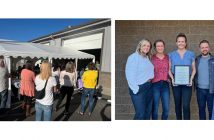Each year, millions of adults aged 65 and older fall. In fact, falling is the leading cause of unintentional injury at home amongst Americans over the age of 65, according to the National Safety Council.
How big is the problem? Falls can cause moderate to severe injuries, including hip fractures and even head trauma. According to the Center for Disease Control and Prevention, in 2013, 2.5 million nonfatal falls among older adults were treated in emergency departments and more than 734,000 of these patients were hospitalized. And in fact, falls are the leading cause of death from injury for those ages 65 and over – and death rates from falls among older men and women have risen sharply over the past decade.
Why do older adults fall? The usual suspects come to mind — slippery rugs, steep stairs, dim hallways or wet bathroom floors. Other reasons could be drowsiness or dizziness caused by medications. Even dehydration or weakness due to changes in our health can affect our sense of balance, including conditions associated with Parkinson’s, stroke or heart disease.
But according to a recent Simon Frazier University study, much more common are falls caused by what researchers call “incorrect transfer or shifting of bodyweight,” which accounted for 41 percent of tumbles. These involve a body movement that caused the center of gravity to change improperly while walking or standing.
The good news? Falls are a public health problem that can be prevented! As suggested by the Center for Disease Control, here are some easy steps older adults can take to reduce their chances of falls and maintain their independence.
Set up a regular exercise schedule.
Although all exercise is good, focus on building leg strength and improving balance. Weight bearing exercise will also help increase bone strength and reduce risk of fractures.
Evaluate your home for hazards.
Make your homes safer by moving potential tripping obstacles out of paths, consider grab bars for your tub and shower and make sure you have railings on both sides of stairways. Move slippery rugs and any unstable furniture out of the way.
Brighten your lights.
Improve lighting throughout your home to ensure the best visibility. Dim hallways can lead to stumbles and falls.
Take care of your bones.
Vitamin D and Calcium are great vitamins to help reduce risk of hip fractures.
Talk to your doctor.
Ask for recommendations to help prevent falling. Perhaps exercises like Yoga or Tai Chi would be beneficial or your provider may recommend physical therapy to help learn you how to transfer body weight correctly.
Check your medications.
Ask your doctor to review your current medications to identify any that might cause dizziness, troubles with balance or drowsiness. While you’re there, ask to be screened for osteoporosis.
Get regular eye exams.
Have your eyes checked at least once a year and update your prescriptions so that your vision is accurate.
The best news? With age comes wisdom. Some of that common sense, mixed with the easy steps below, could help prevent falls – and serious medical
Also, there are tips on line and in our community for keeping your home free from obstacles that could increase your chances of falling. For more information, contact us at www.partnersbend. or call 541-382-5882 and ask for our Transitions community resources.
Lorie Weber is the outreach director at Partners In Care, Central Oregon’s only independent, non-hospital based, not-for-profit hospice, home health and palliative care organization. For more information, visit partnersbend.org





